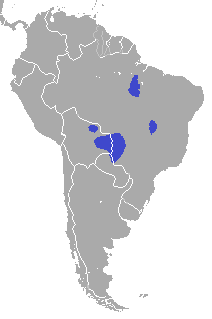Hyacinth macaw
The hyacinth macaw (Anodorhynchus hyacinthinus), or hyacinthine macaw, is a parrot native to central and eastern South America. It is longer than any other species of parrot, from the top of its head to the tip of its long pointed tail it is about 100 cm (3.3 ft). It is the largest macaw and the largest flying parrot species.[2]
| Hyacinth macaw | |
|---|---|

| |
| Specimens in the Pantanal. | |

| |
| A pair of Hyacinth Macaws in Mato Grosso. | |
| Conservation status | |
| Scientific classification | |
| Kingdom: | Animalia |
| Phylum: | Chordata |
| Order: | Psittaciformes |
| Family: | Psittacidae |
| Genus: | Anodorhynchus |
| Species: | A. hyacinthinus
|
| Binomial name | |
| Anodorhynchus hyacinthinus (Latham, 1790)
| |

| |
| Synonyms | |
|
Anodorhynchus maximaliani (Kuhl, 1820) | |
Habitat loss and trapping wild birds for the pet trade has taken a heavy toll on their population in the wild, and as a result the species is classified as endangered on the International Union for Conservation of Nature's Red List,[1] and it is protected by its listing on Appendix I of the Convention on International Trade in Endangered Species of Wild Fauna and Flora (CITES).
They eat nuts from native palms.[3] They have large, powerful beaks that can crack nuts and seeds, while their dry, smooth tongues have a bone inside them that makes them effective for tapping into fruits.[4] The acuri nut is so hard that the parrots cannot feed on it until it has passed through the digestive system of cattle.[3] In addition, they eat fruits and other vegetable matter. Their diet includes fruits, nuts, nectar, and various kinds of seeds. They travel for ripe food over a vast area.[5]
This beautiful bird is endangered. In the wild its eggs are eaten by various small mammals, by vultures, and by the toucan. The hyacinth depends on the toucan, which spreads the seeds of the Manduvi tree (Sterculia apetala) that the macaw needs for reproduction.[6] The tree is just right for the macaw to make its nest, and there are few other places as good. The toucan disperses 83% of the tree's seeds, but also eats 53% of the macaw's eggs.[7] But by far, humans are the main cause of its problems. The illegal trade in fancy feathers, the pet trade and the destruction of habitat has greatly reduced its numbers.[8]
Hyacinth Macaw Media
Captive macaw at La Palmyre Zoo, France
A skeleton exhibited at Dvůr Králové Zoo in Dvůr Králové nad Labem, Czech Republic
References
- ↑ 1.0 1.1 BirdLife International (2014). "Anodorhynchus hyacinthinus". IUCN Red List of Threatened Species. Version 2014.2. International Union for Conservation of Nature.
- ↑ Though the flightless kakapo of New Zealand can outweigh it at up to 3.5 kg.
- ↑ 3.0 3.1 "Hyacinth Macaw". WWF. Archived from the original on 2002-11-04. Retrieved 19 September 2013.
- ↑ "Macaw Psittacidae". National Geographic. Archived from the original on 28 January 2010. Retrieved 24 October 2013.
- ↑ "The real macaw: endangered tropical jewels". Public Broadcasting Service. 26 February 2004. Retrieved 23 December 2014.
- ↑ Pizo, Marco A. et al 2013. Conservation puzzle: endangered hyacinth macaw depends on its nest predator for reproduction. Biological Conservation 143 (3) 792-96. Web Of Science. Web. 23 Oct. 2013.
- ↑ "Hyacinth Macaw Anodorhynchus hyacinthinus". Archived from the original on 29 October 2013. Retrieved 25 October 2013.
- ↑ Collar N.J. & Juniper A.T. Dimensions and causes of the parrot conservation crisis. International Council for Bird Preservation. 1-6, 9,12-15,19.







